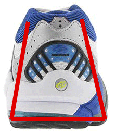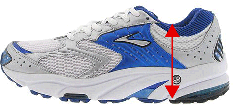Styles change with the season. What might be in fashion this year will be out the next. The ever changing landscape of shoes makes it difficult to recommend a list of specific shoe models for our patients. Nevertheless, it is necessary to provide some guidance for our patients which addresses the characteristics of footwear that are generally preferred.
Dr. Santopietro’s custom orthotics work in concert with a properly fitted and appropriately constructed pair of shoes. A good shoe will provide shock absorption and control the motion of your foot. A well-built shoe will be flexible, durable and long lasting. Because of the complexity of individual foot biomechanics and the complexity of shoes on the market, finding a proper shoe can be a difficult under taking. Dr. Santopietro has compiled a list of manufacturers (both athletic and dress) that may help simplify your choices. Find those listings in the “Footwear” subheading listings on this website.
Anatomy of a Good Shoe:
Shoes or Sneakers for Use With Orthotics:
Width:
The shoe must be wide enough to accommodate an orthotic. In general the wider the better. Some shoes are made in wider sizes (2E for women and 4E for men) and those are often recommended to accommodate an orthotic.
Base:
A wide base is preferred, particularly in the middle of the sole.

Ample width across the sole, especially the midfoot.
Heel Counter:
The heel counter should be deep and firm. It should also be of a pyramidal shape. When properly fit and laced, the foot should never slide out of the heel.
Pyramid shaped heel counter.

Firm deep heel counter

Insole:
The shoe should have a thick removable insert. In fact the thicker the better. This is very important criteria for selecting a shoe that is to be fitted with an orthosis.
Mid-sole:
The mid-sole material should extend into the upper part of the shoe in the mid-foot area. The sole should wrap around the sides of the mid-foot to some extent.
Heel Height:
The heel should be higher than the forefoot by at least 5/8″ and higher, up to 1 1/2″.
Lacing:
The shoe should be a lace up shoe. Laces are among the best methods of controlling how snug the shoe is around the foot. Lace up from the bottom working your way up. A snug but not tight fit is best.
Flexibility:
The shoe should bend at the forefoot joint area, generally under the ball of the foot but NOT in the arch area. For example if the shoe is held firmly at the heel, it should be easily flexed when pushed against the floor at the ball of the foot.
Orthotic Fit:
Finally the shoe should be fit with the orthotic in them. If they are new shoes, it may be advisable to refrain from wearing them until they are fitted with the orthotic. If you want to make an appointment with Dr. Santopietro to fit a new shoe with an exisiting orthotic, please feel free to do so. Many patients make a short appointment for fitting.
Shoes or Sneakers for Use Without an Orthotic or Minimal Orthotics:
Heel Height:
The heel should be raised above the forefoot. Low-heeled shoe or pumps are are a preferred shoe style.
Lacing:
A tie shoe or a tie boot is better than anything that slips on. Tying generally helps to maintain the proper position of the shoe onto the foot
Style:
Generally, a boot style is a bit better because they keep the heel back in the shoe without having to tie laces too tightly.
It is impossible for us to elaborate on every shoe. In general, we prefer any shoe that has a wide sole that extends throughout the base.The Brooks Ariel and Brooks Beast (which are the same model shoe in varying colors for women and men) are good examples of shoes with a wide outer sole extending from the toe to the heel (a wide base is the foundation for healthy foot care). We prefer a firm, deep heel counter with a secure, narrow opening that wraps completely around the ankle such as a boot. An example of a shoe that fails to secure the ankle properly is any open back shoe or clog.The Brooks Ariel/Brooks Beast has a narrow opening that does not allow a significant level of motion in the foot or ankle.

The Brooks Beast delivers maximum support through an engineered combination of sophisticated stability technologies. This shoe is available in a wide range of widths and colors
Overall, we prefer shoes that will house an orthotic, either a full orthotic or a compromised dress orthotic. We understand that our patients will not always wear shoes with orthotics. If the need arises to wear dress shoes, we prefer always a moderate heel over a flat. Avoid bare feet, flip flops and no or low heeled shoes.
For socks, we prefer thin socks over thick socks. However, a thick sock is fine if there is enough room in the sneaker or boot, assuming orthotics are being worn. We like open weave socks with minimal seams and we prefer socks that have some compression, e.g. Lycra. Socks that wrinkle can be problematic. Combination material socks can be good based on personal preference.

Feetures! Running Socks
Feetures! provide the exact amount of compression so each sock gently hugs the foot in a comfortable, supportive way.
To view and try on some of these shoes and more, you may like to go to Simon’s Shoes on Harvard Ave. in Coolidge Corner or these other fine locations in the area:
The shoes we may mention on this website are not necessarily going to fit your needs. Listed are only generalized suggestions and not all of our patients will be able to comfortably wear the shoes we discuss. We recognize that our patient population covers a wide variety of foot types and pathologies that require the appropriate footwear. This is a partial list and there are many other shoes not listed that will accommodate our patients. We will be adding to this list on a regular basis as we research other footwear and get feedback from our patients. We are able to help diagnose your needs and make footwear recommendations to you.